А.Шепс Самолеты Первой мировой войны. Страны Антанты
Моран-Сольнье тип G 1912 г.
После удачного перелета Луи Блерио схема его самолета "Блерио IX" стала образцом для подражания. Подобную схему расчалочного моноплана использовала и фирма "Моран-Сольнье", создавая свой учебно-тренировочный самолет - тип G. Компактная, легкая и дешевая машина стала очень популярной и, кроме Франции, ее покупали или строили по лицензии во многих европейских странах, в том числе и в России. Самолет имел прямоугольный фюзеляж деревянной конструкции с растяжками из рояльной проволоки и обтягивался полотном. В носовой части устанавливался 7-цилиндровый, воздушного охлаждения, звездообразный, ротативный двигатель "Гном" (50, 70 или 80 л. с.). За двигателем устанавливался топливный бак. Дополнительный бак располагался за местом пилота. Самолет считался двухместным, однако пассажир сидел спиной к пилоту на примитивном сиденье в виде скамейки. Капот двигателя изготавливался из металла и был открыт снизу. Крыло двухлонжеронное, имело деревянные лонжероны и нервюры и обтягивалось полотном.
Профиль был довольно вогнутый. Крыло крепилось тремя парами проволочных растяжек через "кабаны" перед кабиной пилота и под фюзеляжем. Оперение без стабилизатора и киля, имело простую конструкцию. Рули высоты имели весовую компенсацию. Шасси на стойках из стальных каплевидных труб, имело шнуровую резиновую амортизацию. Машины типа G выпускались с двумя вариантами крыльев площадью 14-16 м2. Вооружения машина не имела. Единственным оружием в начальный период войны был личный револьвер пилота или карабин у наблюдателя.
Следует отметить отработанность конструкции и ее простоту. Прямо на аэродроме два механика могли собрать упакованный в ящик самолет и отправить в полет за 11 минут.
На "Моране-G" в 1914 году летал и Петр Николаевич Нестеров. 26 августа 1914 года своим "Мораном" он таранил австрийский "Альбатрос" B.I, совершавший разведывательный полет в районе г. Жолкиева на Юго-Западном фронте.
Однако на фронте машины типа G использовались недолго и к началу 1916 года перешли в разряд учебных. На некоторых учебных машинах ставились менее мощные двигатели (35-50 л. с.) и противокапотажные лыжи.
Показатель Моран тип G 1912г. тип H 1913г.
вар. 1 вар. 2
Размеры, м
длина 6,7 6,7 6,28
размах крыльев 9,3 10,2 9,12
высота 2,30
Площадь крыла, м2 14,0 16,0
Вес, кг
максимальный взлетный 550 625 470
пустого 340 350
Двигатель "Гном" "Гном" "Гном"
мощность, л.с. 80 80 80
Скорость, км/ч 122 115 135
Дальность полета, км 200 250
Потолок практический, м 3000 2600 1000
Продолжительность полета, ч 3
Экипаж, чел 1-2 1-2 1
Вооружение нет нет 1 пулемет
В.Шавров История конструкций самолетов в СССР до 1938 г.
"Моран-Ж" ("Моран-Сольнье" , "Моран-М" , "Морже" ). Характерной особенностью этого самолета был четырехгранный фюзеляж, сходивший к хвосту на острую горизонтальную грань, к которой крепился небольшой компенсированный руль высоты. Стабилизатора и киля не было. Впереди фюзеляж замыкался капотом на ротативном двигателе.
Формально самолет считался двухместным, но в его кабине не было обычных двух сидений. На бензобаке лежала подушка в форме восьмерки, пассажир или наблюдатель сидел "в затылок" летчику, причем условия наблюдения для него были неважные из-за среднепланного крыла.
Крылья "Морана-Ж" были двух размеров: размахом 9,3 и 10,2 м при той же хорде 1,8 м, имели площадь 14 и 16 м2 и могли взаимозаменяться на одном и том же фюзеляже. Поэтому самолеты различались по крыльям: "Моран-Ж" 14-метровый и "Моран-Ж" 16-метровый (три пары расчалок вместо двух) с различными летными качествами.
Самолет "Моран-Ж" был одним из лучших перед первой мировой войной. Однако назвать его военным было трудно - он не имел вооружения, что было одной из причин гибели П. Н. Нестерова, вынужденного таранить вражеский самолет колесами своего "Морана".
В конструктивном и эксплуатационном отношении самолет был отработан хорошо, обслуживание его было простым. Трудно поверить, что в 1913 г. этот самолет, запакованный в ящик, мог быть собран и выпущен в полет двумя механиками за 11 минут (по точному хронометрированию от начала отвертывания болтов ящика до отрыва самолета от земли).
Основной вариант "Морана-Ж" независимо от размера крыльев имел двигатель "Гном" (с 1916 г. - "Рон") в 80 л. с. В 1912 г. на нем был "Гном" в 50 л. с., потом в 70 л. с. С конца 1913 г. для возможности выполнения петель Нестерова ("лупинга", как тогда говорили) был увеличен и усилен кабан и введены три пары расчалок. На одном 14-метровом "Моране" летчик Е. Т. Морунов в 1916 г. в Петрограде установил двигатель "Гном-Моносупап" в 100 л. с. Летные качества самолета резко улучшились. На нем была достигнута рекордная для русских самолетов того времени высота - 5200 м, однако его максимальная скорость нам не известна. На самолетах "Моран-Ж" в 1913 г. был выполнен ряд перелетов, в том числе перелеты французского авиатора Бриндежона де Мулине из Парижа в Москву, А. А. Васильева, Леона Летона с Л. А. Галанчнковой из Москвы в Париж. а в 1914 г. перелет П. Н. Нестерова из Москвы в Петербург за 5 часов.
Было четыре учебных варианта самолета "Моран-Ж" с дополнительными передними противокапотажными колесами. Эти самолеты служили главным образом для руления и на них ставились двигатели гораздо меньшей мощности, например "Анзани" в 35 л. с. Учебные "Мораны" были следующие: французский образец - "Моран" на Качинском шасси, "Моран-Ж" учебный Слюсаренко и "Моран-Ж" учебный лейтенанта Фриде. Был и французский вариант "Моран WR".
Следует сказать о попытке летчика Александра Евлампиевича Жукова в 1914 г. в Севастополе поставить "Моран-Ж" на двухпоплавковое шасси типа "Моран-Сольнье". Постройка не была доведена до конца.
Самолеты "Моран-Ж" применялись в военной авиации лишь в первый период войны. Потом они быстро перешли в разряд учебных и тренировочных и поэтому строились в России малыми сериями.
Самолет|| 14-м/ 16-м
Год выпуска||1911/1912
Двигатель , марка||/
мощность, л. с.||80/80
Длина самолета, м||6,7/6,7
Размах крыла, м||9,3/10,2
Площадь крыла, м2||14/16
Масса пустого, кг||340/350
Масса топлива+ масла, кг||76+27/49+19
Масса полной нагрузки, кг||210/275
Полетная масса, кг||550/625
Удельная нагрузка на крыло, кг/м2||39,3/39
Удельная нагрузка на мощность, кг/лс||6,9/7,8
Весовая отдача,%||38/44
Скорость максимальная у земли, км/ч||122/115
Время набора высоты 1000м, мин||7 /10
Время набора высоты 2000м, мин||17/25
Потолок практический, м||3000/2600
Продолжительность полета, ч.||2,2/2,5
L.Opdyke French Aeroplanes Before the Great War (Schiffer)
Deleted by request of (c)Schiffer Publishing
Type Garros: In 1912 the firm built a small monoplane for Roland Garros, who flew it from Tunis to Sicily, and then in stages to Rome. A similar but slightly larger machine followed it, also for Garros, and fitted with floats for his Monaco attempt in 1913. Later in 1913 Morane-Saulnier built 2 more monoplanes for Garros, and in one of them he flew from St Raphael in France to Bizerte in Africa. Work on these monoplanes culminated in the Types G (2-seater), and H (single-seater).
Type G: This straightforward 2-seat monoplane set the standard for many of the following M-S designs. The wing was untapered, and the tips raked forward. The undercarriage was of simple V-design with a V-brace to the center of the axle. The engine was half-covered in a horse-shoe-shaped cowl. An Ecole version with a 3-cylinder Anzani had skids and a support structure under the propeller. Several 3-float seaplane versions were built and raced. There were 2 versions of the basic G - the GA and the GB:
(GA: span: 14 m; speed: 12-124 kmh; 60 hp Gnome, 60 hp Le Rhone)
(GB: span: 16 m; 60 hp and 80 hp Gnome, 80 hp Le Rhone; speed: 123-125 kmh)
Type H: a widely-used single-seater resembling the Type G: perhaps it preceded it. Grahame-White license-built them in England. Several 3-float versions were built as well.
Another M-S monoplane appeared in 1912, with the trapezoidal-tapered wings of the much later Moranes and Nieuports.)
Type O: Similar to the Type H, it was built for the Monaco rally; flown by Roland Garros in the London-Paris race, it featured a reflex airfoil section.
M.Goodall, A.Tagg British Aircraft before the Great War (Schiffer)
Deleted by request of (c)Schiffer Publishing
GRAHAME-WHITE monoplane Type XIV (Morane-Saulnier Types G&H)
An example of the French Morane-Saulnier Type G arrived at Hendon in May 1913, and was sufficiently impressive for the manufacturing rights to be acquired by Grahame-White. One British-built machine was supplied to the RNAS, serial No. 1242, in December 1914, and a batch of twelve to the RFC, serial Nos.587-598, in 1914.
Jane's All The World Aircraft 1913
MORANE-SAULNIER. Soc. de constructions aйronautiques, Morane-Saulnier. 206 Boulevard Pereire. Capital: 1,500,000 francs. School: Villacoublay. Output capacity: about 50 machines a year.
Military, 1913. 2 places.
Tandem.
Length ... ... feet (m.) 21 6.38 21 6.38
Span ... ... feet (m.) 30-1/5 9.20 33? 10.20
Surface ... .. sq. feet (m?.) 151 14 172 16
Weight ... (total ...lbs. (kgs.) 595 270 617 280
(useful ...lbs. (kgs.) ...
Motor ... ... ... h.p. 50 h.p. 80 h.p.
Speed ... ... m.p.h. (km.) 75 120 75 120
Number built during 1912 ... ... ...
In each case body is of rectangular section, wood, mounted on wheels only, except for the military type which has skids also. Fabric: "Aviator" Ramie.
In all there is a rear elevator and a Chauviere tractor.
Note.--Flown in the European Circuit, 1911, by Vedrines, Gajet, Lesire, Morisson, Verept, Frey, Garnier and Dalgier.
J.Forsgren Swedish Military Aircraft 1911-1926 (A Centennial Perspective on Great War Airplanes 68)
Morane-Saulnier MS 3L
In December 1913, Enoch Thulin visited the Paris Salon. One of the various types of airplanes on display was the Morane-Saulnier MS 3L. Determined to a obtain a more modern airplane than the Bleriot XI, Thulin bought one MS 3L. During the spring of 1914, Thulin flew the MS 3L from Paris to Landskrona. He also secured the licence rights for the improved Morane-Saulnier G, with the seven Thulin-built airplanes being designated as the Thulin B.
When war broke out, the MS 3L was bought by the army. The airplane was taken on charge on August 8, and issued with the serial number 5. In September 1914, the MS 3L was flown by Thulin during the annual army exercises. The airplane was slightly damaged when it overturned on landing. When refurbished in 1917, a 90 h.p. Thulin A rotary engine was installed, which resulted in improved overall performance. In 1917/18, the MS 3L was regularly flown by Nils Rodehn when the pair of Thulin K’s were out of action. On April 23,1918, Rodehn reached an altitude of 5,000 metres in the MS 3L, an unofficial Scandinavian altitude record. The serial number was amended to 405 before the MS 3L was struck off charge in June 1918.
Morane Saulnier MS 3L Technical Data and Performance Characteristics
Engine: 1 x 60 h.p. Le Rhone (replaced in 1917 with a 90 h.p. Thulin A)
Length: 6,88 m
Wingspan: 11,18 m
Height: 3,35 m
Wing area: n/a
Empty weight: n/a
Maximum weight: 680 kg
Maximum speed: 130 km/h
Armament: -
Журнал Flight
Flight, May 24, 1913.
THE LATEST MORANE-SAULNIER MONOPLANE.
THE machine with which M. Brindejonc des Moulinais arrived at Hendon on Whit-Sunday from the Continent is quite one of the most interesting that has visited the aerodrome for a long time, and it is all the more interesting to know that Messrs. Grahame-White are arranging to construct duplicates in England in their capacity of sole concessionaires for Britain.
In the hands of such an expert pilot, it formed a centre of attraction during the Whitsuntide meeting, and its flying was certainly something out of the ordinary, and exceedingly well worth watching. But, it was not only in the air that this machine interested those who had an opportunity of seeing it on the ground at close quarters, for its structural detail was full of originality.
This Morane-Saulnier monoplane is, in fact, one of the neatest designs we have seen, but it is impossible to convey an adequate impression of its meritorious points save by illustration, and even sketches and photographs are often an indifferent substitute for an actual inspection.
To some extent the clean appearance of the machine is emphasised by the compactness of its size, for it is far from being a large monoplane. The span is only 30 ft., and the overall length is considerably less. The supporting area is about 160 sq. ft., and the weight of the machine empty is about 680 lbs.
The most striking feature of its design is the undercarriage. Viewed from the side, it is a simple V. Viewed from in front, it represents the letter M. To the inverted apex of the central triangle the divided axle is hinged, and the extremities of the axle are free to rise and fall in slots provided in the lower extremities of the outside limbs of this chassis structure. Rubber shock absorbers are fitted. The entire structure is made of flattened tubular steel work, with brased joints.
Another neat feature is the method in which the main stay wires to the wing spars are carried down to the point of the central V and terminate in adjustment bolts. This also forms the subject of one of our sketches.
The upper pylon is as neat in its conception and execution as the undercarriage, for it is a simple /\ hinged at its two feet to the sides of the body and stayed by a wire cable passing over a pulley, against the pull of the warp wires which pass over a corresponding pulley on the other side. It is, in fact, a simple strut in a system of wire bracing, and when the wires are removed by dismantling the wings for transport, the cabane itself folds down very neatly against the body.
The cockpit is roomy, but the seating accommodation is peculiar, for the passenger sits quite close up to the pilot and has, in fact, to spread his legs in order that the pilot may sit down at all. The control is of the simple vertical lever type in which a to-and-fro movement operates the elevator, while a sideways motion controls the warp. The lever itself is attached to a rock shaft that runs a little way down the body until it comes vertically over the pillar supporting the warp wires. The rudder is controlled as usual by foot. The rudder and warp wires are enclosed in the body of the machine except for a very short length near the extremity, where they are attached to their respective organs.
A peculiarity of the tail is the absence of a fixed horizontal plane, the movable elevator being the only horizontal member. This elevator belongs to what is known as the balanced type, that is to say, its axis of rotation is situated more or less in the position of the usual centre of pressure, so that there is never a very great couple reacting upon the pilot's hand. The rudder is balanced in the same way.
The machine is driven by an overhung 80-h.p. Gnome engine, which is fitted with an 8 ft. Integrale propeller. Two tanks are arranged in the nose of the machine, one containing 14 gallons of petrol, and the other about 5 gallons of oil. A subsidiary petrol tank holding 8 gallons of spirit is located behind the passenger's seat, and there is a hand pump attached to it in a convenient position for transferring its contents to the service tank while in flight.
A Bosch magneto firing Oleo plugs forms the ignition equipment of the engine, while a Tell revolution indicator, a barograph, a compass, and a map-holder are fittings in front of the pilot on the dashboard.
The body of the machine is surfaced with fabric, but its interior structure is of the usual girder type. Ash booms are employed, and ash struts and cross-members are used in the first three bays, pine being employed for the struts further aft.
The wings have no dihedral angle, as the designers object to this feature. The wing spars are of ash, and the leading and trailing edges are fitted with pine stretchers. An internal bracing of piano wire is provided to stay the wing against drift.
Both front and rear spars are hinged to the body, the former by a vertical bolt, and the latter, as usual, by a horizontal bolt to facilitate warping. With the exception of the internal wires, stranded cable is employed throughout for the wing bracing and control.
Flight, May 24, 1913.
FIRST PROSECUTION UNDER AERIAL ACTS.
M. BRINUEJONC DES MOULINAIS, of 206, Boulevard Periere, Paris, appeared before Mr. Dickinson at Bow Street Police Court on the 15th inst., to answer two summonses charging him, as a person in control of an aeroplane, with having, before commencing a journey to the United Kingdom, failed to send notice to the Home Office stating the proposed landing place, the approximate time of arrival, and his name and nationality; further with contravening the orders made by the Home Secretary under the Aerial Navigation Acts, 1911 and 1913, by navigating a certain aircraft, coming from a place outside the United Kingdom, over part of the United Kingdom, viz., the County of London, without having first landed in one of the officially prescribed areas. The defendant pleaded "guilty" and elected to be dealt with summarily.
Mr. Muskett, who appeared on behalf of the Home Office, said invite the magistrate not to take a very serious view of it, and not to impose any penalty unless he thought that the circumstances impelled him to do so. The defendant, who was a young man of about twenty years of age, was a Belgian subject. The Act under which he was summoned provided for a maximum punishment of six months' imprisonment, or a fine of L200, or both imprisonment and a fine. The first Act of Parliament dealing with aeroplanes, was passed in June, 1911, and gave the Secretary of State power, for the purpose of protecting the public from danger, to make orders prohibiting the navigation of aircraft over certain areas. It was found that that Act was insufficient for the purpose, and in the early part of this year another Act was passed which largely extended the powers of the Home Secretary. By virtue of such powers he made an Order, dated March 1st, prohibiting the navigation of aircraft from outside the United Kingdom over the whole of the coast line, except certain prescribed portions. One of these areas was between Margate and Walmer, another between Hove and Bognor, and so on, the area in each instance extending to 5 geographical miles from the coast. From information which had been kindly supplied by Mr. Richard Gates, the general manager of the Hendon aerodrome, it appeared that they were interested in the exploitation of a particular make of aeroplane, and had arranged for the defendant to fly from Bremen to Hendon on Friday last, for the purpose of demonstrating the flying capacities of the machine. Defendant left Bremen on Friday, but descended at Brussels on Saturday, owing to bad weather. He left Brussels on Sunday morning last and flew to Calais, where he descended for lunch. Afterwards, he continued his journey to Hendon, passing over Dover, which was a prohibited area, the magazines at Purfleet, and the Woolwich Arsenal. He was observed to pass over the arsenal at a height of 3,000 ft. and at a tremendous pace. Eventually he arrived at Hendon at 3.15 p.m. on Sunday, having no doubt, accomplished a very marvellous performance. No notice had been given of his intention to fly to this country, and he did not land at either of the prescribed areas. The defendant had intended to return to Bremen on his aeroplane on Monday last. There was no reason to think that he had erred other than through ignorance, and having regard to all the circumstances and to the fact that the defendant had placed no difficulties in the way of the prosecution, as he might have done, he asked the magistrate to exercise the utmost indulgence.
The defendant, in broken English, said that during the last two months he had flown in many countries, having crossed Spain, Belgium, Holland, Germany, and England, and he found it impossible to make himself thoroughly acquainted with the laws of every country. If he had known of this Act he would not have flown within the prohibited areas, as it would have made very little difference to him if he had descended on the coast. He would undertake to observe the law the next time he visited England. He had asked the Aero Club of France, of which he was a member, to advertise the laws of different countries in the newspapers, so that aviators might make themselves acquainted with them.
The magistrate said that we in this country were glad to welcome a brave and clever airman. On the other hand the regulations that had been made for the safety and defence of this realm must be observed. Those regulations had only been in force a short time, and he could quite believe that the defendant had not had an opportunity of studying them. In those circumstances the Government were only too glad to make an exception in this case, but it would be absolutely necessary to observe these rules in future. The defendant would be bound over in his own recognisances in 1,000 francs to come up for judgment if called upon within twelve months.
Flight, July 5, 1913.
PARIS TO LONDON.
EVER since man started to place another element under his subjection by flying and thus conquering the air, it has been one great struggle for mastery, and many a fierce fight has been waged, man sometimes securing the victory, and occasionally having to admit defeat. As time creeps on, however, we are gradually becoming more assured that, as the principles of flight are better understood, man will conquer here, with all reasonable safety, as he has previously conquered the earth and the sea. In writing this article, illustrative of the flight of Robert Slack from Paris to London on the Wednesday of last week on a Morane-Saulnier monoplane, I have in my mind more the showing of how man will win through against fearful odds, than the belittling of any previous Channel flight, of which there have been many, every one of which, in this comparatively early history of flight, deserves to be writ in letters of gold on the scroll of honour, commencing with that memorable flight of Bleriot himself, which, under the conditions then prevailing as to the efficiency of machines, was probably the most wonderful.
Slack went over to Villacoublay to fly the Morane-Saulnier to Hendon, which, knowing Slack, meant that he would arrive, somehow.
On Wednesday, Aerial Fete Day, I was at the Aerodrome at Hendon, when our friend, the megaphone man, announced that Slack had left Folkestone at 10.15, and might be expected to arrive at Hendon during the morning. The wind at this time was blowing half a gale from the north-west, dead against anyone coming to Hendon from the direction of Folkestone, and when I heard the announcement, I said to Capt. Tyrer, who happened to be standing near, "He will surely come down, he couldn't get here against this wind." His reply was, "Bobby won't come down, he'll get here, don't bother." And he did. Before long, we saw him in the distance, buffeted about like a cork in a rough sea, and in a very short time he was safe and sound in the aerodrome, very dirty, very deaf, and very happy.
Slack arrived at Villacoublay on the Monday, but his machine was still in the hands of the constructors; as a matter of fact, it was not finished till late on Tuesday afternoon, when Slack made a trial flight, and decided to set out soon after daybreak on Wednesday morning.
The morning broke wet and stormy, and gave promise of anything but a flying day, but towards five o'clock the rain ceased, and Slack decided to start. A few minutes after five and he was on the wing. He had travelled but a very few miles when once more the rain started, and came down in torrents, and continued to do so all the way to Cape Oris Nez. So bad was the rain, and so low were the clouds, that he saw practically nothing of France as he passed over it, having to fly by the compass all the time, and was out over the Channel without knowing it; in fact his first glimpse of the water was when he was within a mile or so of the English coast, when, whilst flying at a height of about 3,000 ft., he saw through a break in the clouds the waters of the Channel, with the town of Folkestone right ahead. A few minutes previously he had commenced what was really under the circumstances a fight for life.
On the top of the forward tank, and out of reach of the pilot, is a small glass inspection cap, through which the petrol can be seen when being pumped under pressure from the reserve tank into the main one. This cup was evidently cracked when he started, and during the voyage had lost a piece out of the front, and the rush of wind getting in had turned the cup round in its seating till the broken part faced the pilot. It had become necessary when a few miles from Folkestone to pump petrol into the forward tank, which was now nearly empty.
Slack pumped for his life, but the result was that most of the petrol came out through the broken glass and was blown back into his face, very little indeed going in to feed the engine. I have never had the experience of being drenched with petrol myself, but Slack tells me it is not nice and that he was nearly blinded in spite of his goggles, and eventually nearly suffocated owing to the evaporation of the spirit, and at last the worst happened. The engine stopped.
Up to this time Slack had not seen the sea, and had not much idea as to his whereabouts, and it was at this moment Fate was kind and allowed him to see that he was nearing Folkestone, as he slid down the wind.
When a pilot is over a strange town and his engine has stopped "for keeps," he has not much time to waste in finding somewhere to land, and makes for the first piece of green he can see, which in this case was not very large but looked all right from above. Closer inspection, however, showed that it was not ideal. The ground sloped downwards, and had a ridge in the middle like the roof of a house, and parallel to the direction of flight, which meant that he would either have to land downhill on the edge of a slope, or turn round and land uphill with the wind. By this time he was very near the the ground and without power, but judged he had just time to make a sharp turn, which he did, and landed without mishap, the machine coming to rest just before topping the ridge, at 8.40. Three hours and forty minutes to cover roughly 170 miles. A plucky flight. Here he had to send for some more petrol and some tape to bind up the broken glass with, and at 10.15 he was once more off, having got out of a small field without the help of skilled mechanics to give him a start.
From Folkestone the course was direct to Kempton Park, where an almost right-angle turn would have to be made for Hendon. The rain had now commenced again, and it was so misty that at a height of only 1,000 feet it was not possible to see the earth. As flying even so low as that had no advantage, Slack decided to get higher, out of danger, and once more trust to his compass. After flying for about two hours, with occasional dives to try and get a nearer sight of Mother Earth, he decided that he must have overshot the mark, and came down to ascertain his whereabouts, to find that he was still some twelve miles short of Kempton, though flying in the right direction. In two hours he had only covered 65 miles, although the machine can fly 80 miles an hour; such was the strength of the wind.
Here he bought some more petrol, and after a stop of about thirty minutes - meanwhile it having left off raining - set out once more for Hendon, where he arrived at 1.41 p.m., having been actually in the air for 6 hrs. 36 mins. to fly about 260 miles. Bravo, Slack! a very fine flight!
Flight, July 26, 1913.
FOREIGN AVIATION NEWS.
The Match at Juvisy.
JUVISY, on Sunday last, was the scene of a three-cornered match between Brindejonc des Moulinais, Audemars, and Guillaux. The first contest was for speed, and in the first heat Audemars on a Morane beat Guillaux on his Clement-Bayard, the former's time for the 20 kiloms. being 10 mins. 46 3/5 secs. In the second heat, Brindejonc, also on a Morane, beat Guillaux, his time being the same as Audemais. Audemars then beat Brindejonc, but in the final, Bindejonc turned the tables on his rival, and by covering the 20 kiloms. in 10 mins. 16 2/5 secs., won the match. During an interval, Champel improved the shining hour by taking up two and three passengers at a time on his great biplane with 100 h.p. Anzani motor. The last event was an altitude contest, the maximum time being half an hour. Audemars went highest, 3,800 metres, but as he stayed up 35 mins. he had to be disqualified, and the prize awarded to Brindejonc, who went up 3,000 metres in 28 mins 57 secs. Guillaux was second with 1,320 metres.
Flight, September 20, 1913.
THE AERIAL DERBY.
PILOTS AND HOW TO RECOGNISE THE MACHINES.
No. 10. The Morane-Sauinler Monoplane.
The main planes of this machine are characteristic in that the trailing edge is longer than the leading edge. The landing chassis is not provided with any skids, and the fuselage is covered throughout its entire length.
No. 11. The 80 h.p. Morane-Saulnier Monoplane
This machine differs from No. 10 only in engine power, and the number on the wings will have to be depended upon for purposes of identification.
No. 15. Morane-Saulnier.
Similar to Nos. 10 and 11.
THE MACHINES, WITH SOME DETAILS.
Nos. 10, 11 and 15. The Morane-Saulnier monoplane has leapt into public favour in a remarkable manner during the last few months; its popularity in England dating, perhaps, from the visit to Hendon of the world-famous Brindejonc des Moulinais.
They are very swift monoplanes, their speed varying, of course, with the engine power, from about 75 m.p.h. in the 50 h.p. model to about 85 m.p.h., or even more, in the 80 h.p. model.
The whole machine is quite small - the span is about 30 ft., and there is no dihedral angle. The tail is extremely small, and is characterised by the absence of fixed tail-planes.
Flight, December 13, 1913.
THE STANDS AT THE PARIS AERO SHOW.
MORANE-SAULNIER.
Of the machines on the Morane-Saulnier stand, the one which attracts most attention is the "Parasol" monoplane, which has the wings mounted some distance above the fuselage. This arrangement has, of course, the very great advantage that an excellent view of the country is obtained, as the planes are above the pilot's head, and he thus has an unrestricted view in a downward direction. This machine is a tandem two-seater, the pilot occupying the front seat. Inside the fuselage, and behind the observer's seat is situated a special camera, which is pointed straight downward, so that photographs may be taken while the machine is in flight. The camera is operated from the observer's seat by means of a single string, which serves the double purpose of actuating the shutter and the plate-changing mechanism. Mounted on a slanting support, which gives it the appearance of doing a right-hand spiral, is a replica of the machine in which M. Garros made his famous flight across the Mediterranean, from Tunis to Rome. A third standard type two-seater, having the seats placed immediately behind one another, completes the Morane-Saulnier exhibit. The snowy white fabric with which these machines are covered, in connection with the black metal work and edgings, makes this exhibit one of the most graceful at the show.
Flight, February 7, 1914.
Mr. Hamel Flies Before the King.
HAVING received a command to give an exhibition before Their Majesties the King and Queen, Mr. Hamel flew from Hendon to Windsor on Thursday of last week, arriving at the Castle at about 12.45 P.m. After flying for about ten minutes over and round the Castle, Hamel alighted on the East Terrace. He was presented to Their Majesties, and the King and Queen inspected the machine. The Royal party included Princess Mary, Prince Henry and Prince John. The news of Mr. Hamel's intended visit leaked out, and a large crowd gathered within the Castle grounds and at other vantage points, Mr. Hamel had the honour of an invitation to luncheon at the Castle. At 2.30 p.m. he was again in the air giving a demonstration of high flying before Their Majesties, and hall an hour later he disappeared in the direction of Hendon; and upon this occasion Mr. Hamel did not loop the loop, but this part of the programme was carried out during another visit to Windsor on Monday. A few minutes after twelve Mr. Hamel arrived on his 80 h.p. Morane-Saulnier machine and vol planed down to the East Lawn, where Their Majesties the King and Queen, with the Princess Royal, Princess Maud and Prince John were waiting. At 12.30 p.m. Mr. Hamel ascended again, and in the course of a 17-min. flight made fourteen loops. After luncheon at the Castle Mr. Hamel gave another display of looping before returning by the air-way to Hendon.
Flight, April 18, 1914.
LOOPING THE LOOP.
A PILOT'S AND A PASSENGER'S IMPRESSIONS.
IT was just a year ago that I gave my impressions in FLIGHT of Chevillard's chute de cote. I thought it a wonderful experience then and said I would not forget it until someone took me up and flew a couple of miles upside down. I little thought at the time that it would really be possible for such a thing to happen, but aviation has made very rapid strides since then. I have not yet flown that two miles upside down, although it is now a by no means impossible proposition, but I have experienced the next thing to it - looping the loop, and I think that I must admit that the chute de cote is put in the shade somewhat by this latest method of flying. Before I received my bapteme de boucle le boucle I asked Louis Noel, who by the way, is the first pilot to loop the loop on both biplane and monoplane, to give me his impressions of looping, and I cannot do better than record them here in his own words. Thus Louis Noel:-
"In asking me for my impressions of looping the loop, I fear you have given me a difficult problem; however, I will try, but I really think there are no words in which to express the sensation. As it is, the ordinary flight is quite exhilarating, but this new stunt quite exceeds everything in the world: in fact, in a word it is superhuman. When once you have done it you feel you must repeat it again and again; you are so intoxicated with the wonderful sensation. You start off, and rise to a height of between 600 ft. and 700 ft., and then you can begin the joke absolutely without danger. After executing a gentle vol pique you pull the lever back, and the 'bus leaps with tremendous speed upwards - which it loses at the zenith of the loop. At this moment you are completely isolated from the earth and you can see nothing but the planes. Then it is that an incomprehensible sensation runs through you at being absolutely alone, suspended by an invisible string amid air. I assure you it is a unique position; nothing to fear - only happiness. All this of course (unfortunately) is done and finished in a second or so, and, after diving again, you have the first glimpse of the earth under you and you can only regret that the looping is over. There is just one thing to consider, however; I think that if I 'loop' often I shall lose that wonderful feeling."
This last statement of Mr. Noel's is, I think, rather interesting, for although, no doubt, there would always be a certain amount of exhilaration when looping, the first sensations are so strange, so unlike anything one previously imagined, yet not so very startling, and the whole proceedure is over so quickly, that once you have done it you feel that you have been doing it always, and the strangeness wears off. I asked Noel if he felt safe, and he said "absolutely," adding :-
"Many people witnessing a looping exhibition think surely the pilot is risking his life; nothing of the kind! On a suitable machine it is quite safe, and a competent pilot will find that he will accomplish his first 'loop' far more easily than his first straight flight, and I agree with Hucks that every well-trained, good pilot can do it easily.
"Again, people say that it serves no useful purpose, but I think otherwise; it is well to know how to do everything it is possible to do, and at the present stage of aviation I feel safer on a 'looping' machine than on a machine on which it is dangerous to do it."
"Well," he said," those are my impressions: but why not loop the loop yourself, and see if you agree with me?" And so, on Saturday last, I ascended with Noel on the rebuilt "G.-W." 80 h.p.. Le Rhone-Morane-Saulnier monoplane, and "saw for myself." I might mention here that Noel took out the Morane-Saulnier for the first time in his life on Good Friday, and succeeded in executing two loops with a passenger. My own impressions of looping are much the same as Noel's, but there is one point that has struck me particularly, and that is the fact that I could not realise that I was upside down. I did not feel any tendency to fall out, and if I had shut my eyes I would not have known, for the greater part of the time, that we were not flying normally. Before I ascended I took the precaution of seeing that what little coin of the realm I had in my pocket would not fall out when in an inverted position, but, as I found later, quite unnecessarily, for, once in a way, my money remained quite securely in my pocket. As far as I can put it in words, my sensations from start to finish were as follows :- After climbing to a height of about 600 ft., Noel turned and inquired if I was ready, and then we dived slightly, the feeling in this case being similar to that during a vol plane; the ground stretched out before us, then suddenly "rolled" out of sight as the nose of the machine was turned upwards, and there was nothing but the clouded sky all round. The rush of wind, which had been intense, then seemed to die out altogether for a second or so, and now one felt that wonderful feeling Noel spoke of, of being absolutely alone and extraordinarily happy. The next sensation was exceptionally weird, for suddenly there was a terrific rush of air and the earth came into view from behind and above, and passed with startling rapidity in front of the machine, just as if someone had thrown a roll of green cloth over one's head from behind so that it unrolled as it went. As the ground passed from overhead to the front of the machine, the sky again came into view overhead, coming up from behind as did the earth, and I realised then that we were diving and that we had been upside down. All this time I felt absolutely comfortable in my seat and it was only when we were recovering, our normal position that I felt any rough movement. Each time we made the loop we came out of the top of it slightly sideways, so that when the horizon line appeared above our heads it was not absolutely horizontal. As I said before, although I saw, for the space of two or three seconds, the ground stretched out above my head, I had no feeling of being upside down, owing, no doubt, to the fact that centrifugal force made my position feel quite normal. Yes! looping the loop is a really magnificent experience - but I do not propose this time to say that I will not forget it until someone takes me up in an aeroplane and does something or other remarkable, for I cannot think of anything impossible enough now for an aviator or pilot to do.
"VEE JAY."
Flight, May 2, 1914.
FLYING AT HENDON.
<...>
Glorious weather favoured the flying exhibitions on Sunday, and there was again a large attendance in all the enclosures. The following contributed to the afternoon's flying : - Claude Grahame-White, R. H. Carr, and Louis Noel made several trips on the G.-W. five-seater aerobus, three or four passengers being taken up at a time. F. W. Goodden went up on the 60 h.p. Caudron, and looped several times, and Philippe Marty also gave looping demonstrations on the 60 h.p. Morane-Saulnier, and ascended to an altitude of 7,500 ft. P. Verrier flew two new Farman biplanes, one at a time, of course - and numerous other flights were made by E. Baumann on the 40 h.p. Wright, J. L. Hall on his 50 h.p. Avro, L. A. Strange on the G.-W. tractor biplane "Lizzie," and W. Birchenough, J. M. Cripps, and R. J. Lillywhite on G.-W. 'buses. Marty's unfortunate accident occurred at about 6 o'clock. He was descending from one of his brilliant exhibitions with a rather steep dive, and when about 150 feet from the ground he started a spiral, which got sharper and sharper, until finally the machine plunged nose first to the ground, not far from No. I pylon. The machine struck the ground with such force that the fuselage telescoped, breaking in half just behind the unfortunate pilot, whilst the rest of the machine was totally wrecked. Marty was removed from the wreckage with difficulty, and though he was still alive it was seen that he was terribly injured, but fortunately unconscious. After being carried to the aerodrome hospital, where he received first aid, he was removed to the Central London Sick Asylum, and there passed away. Poor little Marty was only 21 years old, yet a magnificent and careful flyer. He was very popular everywhere in aviation circles, his unassuming, good-natured manners charming all who met him, and so he will be missed by many. How his accident originated is yet to be ascertained, but there is little doubt that had he been higher up when the machine got out of control, he would have been able to save himself.
Flight, May 9, 1914.
THE FATAL ACCIDENT TO MARTY.
IN connection with the accident which resulted in the death of Philippe Marty on Sunday week, an inquest was held at Hendon on the 29th ult.
John Stanton Chapman stated that Marty had given an exhibition of trick flying, and just before the accident he had been making some small circles with the engine off. The machine was about 100 ft. from the ground when the engine was shut off, and the machine fell head first to the ground.
Harold G. Carpenter also gave similar evidence.
Louis Noel said he tried Marty's machine earlier in the afternoon and found it all right. After the accident he examined it and ascertained that the controls were in order.
Richard T. Gates, general manager of the Grahame-White Aviation Co., said that in his last flight Marty flew several times round the course, and while doing so switched his engine on and off. That was done in order to reduce the speed of the machine - to try to fly at a slow speed. Marty was descending when he began a spiral. He did not do many circles, but those he did were very small and were not banked. Apparently Marty's intention was to go round and round and land, and when he was 40 ft. or 50 ft. from the ground the machine was perfectly straight. It seemed to bank a little, then stay motionless, then tip onus nose and dive to the ground. Witness thought that was brought about by the fact that Marty lost his speed, consequently bringing the machine round at a slow turn. If he had had another 250 ft. to drop he would probably have been able to operate his elevator successfully. Mr. Gates said he had no doubt that Marty was endeavouring to straighten the machine out as it came down, but it had not sufficient velocity to enable the elevators to act efficiently. The machine was passing too slowly through the air for the elevators to act efficiently and control the machine. Marty was an experienced aviator, and had a wonderful record for one so young. Possibly the accident was due to the fact that Marty left his motor switched off too long.
Mr. Grahame-White said that he did not see the accident, but from inquiries he had made he formed the opinion that Marty got into a steep spiral with his engine switched off, and there was a possibility that he switched on again and his motor would not go. Such a thing did happen sometimes. Failing that it might have been an error of judgment. Aviators, however skilled, did make such errors sometimes. Mr. Grahame-White said that he had just given permission to Marty to go to France for a week, and there was no necessity for him to have gone up again that evening.
The jury returned a verdict of "accidental death."
The remains of Philippe Marty were taken to France for interment on Thursday evening, and the coffin was borne to the funeral compartment in the boat express at Charing Cross by a party of men, under Superintendent Muller, from the 56th division of the St. John Ambulance Association. In the procession which followed were M. Maurice Marty (brother), Mr. H. E. Penin (secretary, Royal Aero Club), Mr. Richard T. Gates (General Manager of the London Aerodrome), Mr. B. Isaac (secretary), Messrs. Louis Noel, W. Birchenough, Beatty, Howarth, Baumann, Carr, and Strange, with about a score of mechanics also from the aerodrome. Among the many floral tributes was one in the form of a monoplane "From Hendon Aviation Pupils and the Staff of the Aerodrome."
Flight, May 22, 1914.
THE AERIAL DERBY.
THE PILOTS AND HOW TO RECOGNISE THE MACHINES.
No. 10. The 80 h.p. Morane Monoplane.
The best means for identification of this machine is its straight, angular wing tips and its landing chassis, which, as will be seen from the accompanying silhouette, has no skids.
No. 12. The 80 h.p. Morane Monoplane
is similar to machine No. 10.
No. 17. The 80 h.p. Morane Monoplane
is exactly similar to Nos. 10 and 12
No. 21. The 80 or 160 h.p. Morane Monoplane
will be similar in outward appearance to the other Moranes entered.
THE MACHINES AND HOW TO RECOGNISE THEM.
Nos. 10, 12, 17 and 21. The Morane-Saulnier Monoplanes are similar to the machines flown so successfully by Hamel, Noel and the late M. Marty, to mention just a few of the pilots who favour this machine. As scale drawings and a detailed description of the Morane-Saulnier monoplane have already appeared in the columns of FLIGHT, it is unnecessary to describe the machines in detail here. Suffice it to say that they are very fast, and as at least three of them are equipped with 80 h.p. engines, they should be particularly well matched. There is a possibility that Mr. Hamel will be using a 160 h. p. Gnome in his Morane, but failing to obtain this engine in time for the race, he will in all probability use the ordinary 80 h.p. type.
Flight, May 29, 1914.
GUSTAV HAMEL.
IT is with profound regret that we have been forced to the conclusion, as we state elsewhere, that Mr. Gustav Hamel came to an untimely end during his Channel trip which he started on Saturday morning last. Briefly the record of his movements shows that Hamel left Villacoublay at 4 40 a.m. on the new Morane monoplane with 80 h.p. Gnome monosoupape engine with which he proposed to compete in the Aerial Derby last Saturday afternoon. At 5.22 he reached Le Crotoy, and having breakfasted, he left at 8.30 for Hardelot, where he landed half an hour later. There he rested for a couple of hours, then had a light lunch, filled up the fuel and oil tanks of his machine, and left Hardelot at a quarter past 12. From that time nothing is known of the airman's movements, although the Cross-Channel steamer "Riviera" reported seeing an aeroplane flying in mid-Channel on Saturday afternoon.
Hamel was one who had done very much for the cause of aviation in this country. The son of a well-known English surgeon and a clever motor driver, it was not surprising that aviation should attract him. Having studied the question in France, he set to work and qualified for a French certificate on a Morane monoplane on February 3rd, 1911. Returning to England he repeated the necessary tests on a Bleriot monoplane, and obtained a British certificate on February t4th, 1911. He quickly showed that he was master of the Bleriot type of machine, and he was selected to pilot a Bleriot racing monoplane in the Gordon Bennet race at Eastchurch, in July, 1911. It will be recalled that on the morning of the event, a trial flight showed that the machine was slightly slower than some of his rivals' mounts. With the object of augmenting the speed, M. Bleriot decided to shorten the already very small wings, but, in the race, when rounding the first pylon, Hamel's machine side-slipped to the ground, no doubt owing to his taking too sharp a turn. The pilot was fortunately thrown clear and escaped with very severe concussion.
In July he took part in the Circuit of Britain, and after a good deal of engine trouble he was forced to retire at Dumfries. In the following September he took the principal part in the aerial post between Hendon and Windsor, flying in spite of the high winds. In the Aerial Derby of 1912 he secured the second place, last year seeing him a very popular winner of the event, whilst he was the favourite for the race which was to have been held last Saturday, the day of his disappearance. Of his many Cross-Channel trips, one of the most outstanding was that made in the course of his flight from Dover to Cologne on the Bleriot machine which was subsequently presented to the New Zealand Government.
In a match against Hucks over a course round Birmingham last August, Hamel secured a victory by a narrow margin. He won several races at Hendon, and his flying there and at Brooklands was always highly popular, especially since last November, when he added looping the loop on the Morane to his accomplishments, and he had the honour of twice being commanded to "loop" before the King at Windsor.
Flight, July 17, 1914.
THE LONDON-PARIS-LONDON AIR RACE.
ONCE more has Walter L. Brock "chewed" his way to victory, for the third of our big aviation events this year has fallen to this remarkable American flyer. As in the case of the Aerial Derby round London, and the London-Manchester-London races, Brock, as his fellow countrymen would put it, went straight for it and "got there" without any fuss or bother, and on each occasion he flew over the courses - which in two cases were quite unknown to him - under more or less unfavourable weather conditions with a remarkable degree of accuracy. This "hat trick" of his has, therefore, proved that he is undoubtedly a master of his art, and that his victory is not merely a question of luck alone. Credit is also due to his 80 h.p. Gnome-Morane-Saulnier and its makers, the Graharne-White Aviation Co. Although following the general design of the French machines, Brock's Morane - which, by the way, has done over 1,000 miles without any extensive repairs, possesses several modifications, mostly as regards dimensions Brock's win is also remarkable in that out of the six actual starters he and Garros alone completed the double journey the same day. Although only these two finished - with Renaux classed third on Sunday - it was none the less an interesting race, with several exciting incidents, whilst not a single serious accident marred the proceedings. Considerable interest was attached to the race on account of the entry of seven well-known continental flyers.
The first of these to arrive over here was Eugene Renaux, who flew over from Paris on a 120 h.p. Renault-Maurice Farman ("headless" type) with a passenger on Thursday, the 9th inst. Roland Garros, one of the favourites of the race, started from Paris at 4.20 a.m. on Friday on his 80 h.p. Le Rhone-Morane Saulnier, arriving at Hendon at about 10 a.m., after having made descents, owing to engine trouble, at Calais and in Kent. Helmuth Hirth, of Albatros fame, also started off on an 80 h.p. Le Rhone-Morane-Saulnier in company with Garros, and he too had engine trouble and descended near Surbiton, arriving at Hendon in the afternoon. The machine flown by Garros differed somewhat from the other Morane-Saulniers in the race, having a slightly modified chassis and a peculiar wing section not unlike that of the Nieuport, whilst Hirth's machine was similar to the one flown over here by Brindejonc de Moulinais. P. Daucourt, flying the 80 h.p. Clement Bayard monoplane, got as far as Crotoy, but was unable to continue to London. Lenoir on the 80 h.p. Ponnier monoplane damaged his machine at Courtenay on his way to London, whilst M. A. Parmelin on the 80 h.p. Deperdussin monoplane, after departing from Villacoublay for London, fell and smashed his machine when only just outside the aerodrome, fortunately without injury to himself.
Several test and speed flights were made at Hendon on Friday last by Garros, Carbery (80 h.p. Le Rhone-Bristol scout biplane), R. H. Carr and W. L. Brock. The former's machine developing engine trouble, mechanics, superintended by M. Saulnier himself, worked on the engine up to a late hour. R. R. Skene left Brooklands for Hendon on the 120 h.p. Martinsyde, but descended at Potter's Bar owing to engine trouble. Early in the afternoon, whilst Louis Noel was looking over his machine, he discovered that the petrol tank was leaking, and the rest of the evening was spent in putting it right.
Everyone was agog early on Saturday morning, and by 5.30 a.m. a good many people were on the ground. The weather was not at all promising, and it looked as though the elements were going to be unkind for the third time. Although there was a slight breeze and the sun was making every effort to show itself, a thick mist and clouds hung around the aerodrome at a low altitude, so low, in fact, that when Garros went up for a test flight at 5.45 a.m. he disappeared among the clouds at an altitude of scarcely more than 100 ft. Shortly before 6.30 a.m. Hirth made a test flight on his Morane-Saulnier, but his engine was running so badly that on landing it was partly taken down in order to locate the trouble. As there was but little improvement in the weather, the start was postponed to 7.30, and even at this hour it was as bad as ever. Reports from Dover being favourable, however, it was decided to make a start. Skene was expected at any moment, but by now there was little hope of any of the missing continental pilots arriving. The starting times and handicaps of the remaining competitors were as follows :-
No. Pilot and Machine. Handicap. Clock Start (a.m.).
h. m. h. m.
14. T.E. Hearn, with Mrs. Hearn as passenger
(80 h.p. Bleriot monoplane) 3 18 7 30
12. E. Renaux, with Miss Unwin as passenger
(120 h.p. Maurice Farman biplane) 2 21 7 35
7. Louis Noel (80 h.p. Morane-Saulnier mono.) 1 43 7 40
6. W. L. Brock (80h.p. Morane-Saulnier mono.) 1 36 7 45
8. R. H. Carr (80 h.p. Morane-Saulnier mono.) 1 30 7 50
3. H. Hirth (80 h.p. Morane-Saulnier mono.) 1 18 (non start)
10. R. R. Skene (120 h.p. Martinsyde mono.) 0 32 (non start)
2. R. Garros (80 h.p. Morane-Saulnier mono.) 0 32 8 5
1. Lord Carbery (80 h.p. Bristol biplane) scratch 8 10
Hearn, who employed a Rubery Owen quick release, did not get more than a few hundred yards before his engine stopped, and after a short interval he made another start, but descended on completing a couple of circuits of the aerodrome, and retired from the race. Renaux and his passenger were soon lost to view in the mist, but he had not been gone very long when he was seen returning. On landing he informed us that he was unable to find his way, as he could not see the ground at all, and so he decided to return. He made a second start, however, about an hour later. Carr, Brock and Noel all got away in fine style, but Hitth still had trouble with his engine, and so retired. The next man to start, therefore, was Garros, as Skene had not turned up. Garros misunderstood the signal to start and lost a few seconds in getting away, whilst his engine still appeared to give trouble. The last to go off was Carbery on the Bristol, and he got away in a very shaky manner, the machine being heavily loaded with petrol and oil. With the exception of Renaux and Garros all the starters wore Boddy life-saving jackets, which made them look somewhat like skippers of flying life-boats.
The last of the competitors having gone, it remained but to await news of progress along the route, and in the meantime to partake of breakfast, which, thanks to the excellent catering arrangements on the ground, was an easy and pleasant matter.
By now the weather was clearing, and giving promise of a hot and sunny day. Very shortly news came to hand that Brock had passed over Epsom at 8.2 a.m. and was flying well, whilst Garros was seen circling over Epsom Downs as though he was uncertain of his direction. A little later we heard that Carr had lost his way and had descended at Kenton, near Harrow, and that Noel had come to grief at Camber, near Rye. Noel had already started on the Channel trip when the petrol pipe broke, so he immediately turned and glided back to shore, just managing to land some 300 yards from the sea. After waiting about an hour at Kenton, Carr resumed his journey and descended once more near Dymchurch, near Hythe, where he decided to abandon the race and return to Hendon, and on landing at Ashford (Kent) on the return journey he damaged the landing chassis. There were now only four in the race, and many began to doubt if any would get to Paris, let alone return to Hendon.
Renaux landed at Epsom to enquire his way, and also at Gravesend. Brock passed over Boulogne at 9.15 a.m., Garros at 9.50 a.m., and Carbery at 10.19 a.m. Brock landed at Hardelot at 9.24 a.m. to fill up with petrol, and departed 15 mins. later, arriving at Buc 11.18 a.m. Carbery was the next to reach Paris, landing at 12.4, five mins. ahead of Garros. Brock got away immediately his two hours' compulsory stop was up, but Garros lost some considerable time in starting on the return journey, as the engine had to be overhauled (a new magneto and propeller were fitted). On the return journey Brock reached Hardelot at about three o'clock, where he stayed 12 mins. in order to fill up with petrol, and passed over Folkestone at 3.45 p.m., Epsom at 4.28 p.m., arriving at Hendon at 4 h. 48 m. 6 s., his average speed for the whole journey being 71 m.p.h. Needless to say, the reception he got was tremendous, and the scene immediately after his landing was one to be remembered. Long before the machine came to rest it was surrounded by an enthusiastic crowd that overwhelmed him with greetings and questions. The machine at last came to rest close to No. 1 pylon, and Brock stood up in his seat, silent, but smiling and chewing. First he took off his "Boddy" jacket, and then felt in his pocket and produced a letter, which he delivered to someone in a casual sort of way. His next procedure was to return his small pocket camera, which together with his foot rule he always carries with him wherever he goes, to its case. He then produced a large packet of records, and another letter, which he duly handed over to an official, and then surrendered himself to those awaiting to chair him. All this time he was silent, smiling, and chewing! Brock, guess you're some marvel! Although Brock was the first home, it was still a matter of 15 minutes before he could be declared the winner of the trophy, for Garros started that much behind him, and so the Frenchman had a chance of winning if he reached Hendon within that time. However, it soon became apparent that Garros would not be able to get in soon enough, for it was announced that he had passed over Folkestone at 5.12 p.m., and so Brock was presented with the trophy by. Lady Reid, the wife of Sir George Reid, High Commissioner for Australia. Speeches were made by Claude Grahame-White, Sir George Reid, and - a very, very short one - by Brock. Grahame-White referred to the nationality of the event, a British built machine of French design piloted by an American, and said that this kind of flight would in a very short time be quite a common occurrence - lunch in Paris and back in London for tea. He also made brief reference to the all-British attempt for the Atlantic flight.
An amusing and perhaps alarming incident occurred whilst the speechmaking was in progress, for Verrier, who was "stunting" on his Maurice Farman, suddenly swooped down over the presentation group, causing several to scatter in all directions. At about 6.20 p.m. Garros was sighted approaching in the direction of the Welsh Harp, which seemed to indicate that he had not passed Harrow, so when he landed he was asked if he had, and not being sure, he started off immediately to do so, returning soon after, and crossing the line at 6 h. 28 m. 47 s., thus obtaining second place. In the meanwhile it had been announced that Carbery had left Hardelot at 4.55 p.m., and should arrive at Hendon at about seven o'clock. News also came to hand that Renaux had arrived at Paris at 2.48 p.m., having passed Folkestone at 11.8 a.m., and Boulogne at 11.39 a.m. After a stop of two hours he resumed his journey, and landed at Boulogne at 7.45 p.m., still with his passenger. For some time after the hour at which he was expected, there was no news of Carbery, and some considerable anxiety was felt as to his safety. The Admiralty was communicated with, as it was feared that he had fallen into the Channel. Shortly before nine o'clock it was ascertained that this was the case, but happily the pilot was safe and sound. It appeared that whilst crossing the Channel, engine trouble developed so the pilot made for a tramp steamer, and as he did so his engine gave out. He planed down and alighted on the water as close to the steamer as possible, and was soon picked up by the latter dry and unhurt. The machine, in a damaged condition, was also salved. Later Lord Carbery was transferred to H.M.S. "St. Vincent," where he was well looked after by the officers, and eventually landed on Folkestone Pier.
E. Renaux, with Miss Unwin as passenger, left Boulogne on Sunday at 9.30 a.m. for Hendon, via Calais, arriving at Hendon at 12.25 P.m. He was thus the third pilot to return, and was therefore allotted third prize in the handicap. Thus ended the first London-Paris-London Air Race.
Notes of the Race.
Each of the starters carried a letter from the French Ambassador in London to the British Ambassador in Paris. Brock brought back from Paris a reply which was delivered to M. Morand.
On arriving at Paris, Brock handed over a number of postcards, stamped and addressed, and asked someone to post them for him. He soon found an old friend in Sabelli, and had a chat with him over old times whilst partaking of some refreshment. Throughout the whole journey, Brock never flew higher than 2,000 ft.
At Buc aerodrome there were many well-known personages connected with aviation, amongst whom may be mentioned M. and Mme. Bleriot, MM. C. T, Weymann, P. Prier, Jules Vedrines, Molla, Deutsch de la Meurth, Farman (sen.), and Sanchez, &c.
The following is a complete time-table of the race from start to finish, whilst elsewhere will be found further particulars of the flying at Hendon on Thursday, during the race, and on the Sunday following :-
Result of First London-Paris-London Air Race.
Prizes.- Fastest Time: Trophy and L500 presented by the International Correspondence Schools.
W. L. Brock (80 h.p. Gnome-Morane-Saulnier monoplane).
Handicap.-1st, L300, presented by the Royal Aero Club; 2nd, L150; and 3rd, L50, Presented by the International Correspondence Schools.
Times of Competitors
Hendon Pass Pass Paris Paris Pass Pass Hendon
Dep. Epsom. Boulogne Arr. Dep. Folkestone Epsom. Arr.
W. L. Brock 7 45 8 2 9 15 11 18 1 18 3 45 4 28 4 48 6
R. Garros 8 5 8 27 9 50 12 10 2 35 5 12 5 55 6 33 47
J. Carbery 8 10 - 10 19 12 4 2 4+ - - -
E. Renaux 7 35* 9 15 11 9 2 49 4 49++ Sunday aft., 12 25.
*Actually started at 8.23 a.m.
+Descended in mid-Channel.
++Landed at Boulogne, 7.45 p.m.
Handicap Time. Flying Time. Average Speed,
h. m. s. h. m. s. m.p.h.
1. W. L. Brock 5 27 6 7 3 6 71.5
2. R. Garros 7 56 47 8 28 47 58.8
3. E. Renaux 24 34 0 26 55 0 -
Flying Times Between London and Paris.
London-Paris. Paris-London. Total.
h. m. s. h. m. s. h. m. s.
W. L. Brock 3 33 24 3 29 42 7 3 6
R. Garros 4 5 42 4 23 15 8 28 57
J. Carbery 3 54 0 - -
E. Renaux 7 14 50 19 40 10 -
Flight, November 13, 1914.
WIRELESS TELEGRAPHY AND AIRCRAFT.
BEARING in mind the great part which scouting by aero planes has played in the present war, and the necessity for means of communication to and from the reconnoitering machine, a description of one of the systems of wireless installations fitted to aircraft should be of interest to our readers. It may be useful, first of all, to briefly sketch the elementary principles of wireless telegraphy for the benefit of those who may be unacquainted with this important method of communication. The fundamental basis of wireless telegraphy consists of the following electric phenomenon. If an electric current flowing through a circuit consisting, say, of a coil of wire, is intermittently interrupted, or if the direction of flow of the current alternates, a varying magnetic field will be set up round the circuit which will induce secondary currents in an entirely independent circuit placed some distance away from the first or primary circuit. Thus, a telephone receiver inserted in the secondary circuit will respond to these interruptions or reversals of current in the primary circuit. The distance at which the secondary circuit can be so affected is somewhat limited, but similar forms of induction -over great distances can be caused by means of electro-magnetic waves produced by the surging backwards and forwards of an electric current in a length of wire termed an "aerial." These waves, which have the velocity of light, are known as Hertzian waves, and are employed in the Marconi system of wireless telegraphy. How these waves are brought about and caused to transmit messages, may briefly be explained with the help of the accompanying diagrams. Fig. 1 shows the simplest form of transmitting and receiving apparatus, in which A represents the aerial, a long wire carried by a mast and insulated from the earth. The lower end of the aerial is connected to one of a pair of spark balls, S, of an induction coil, I. The other spark ball is connected by a wire to the earth, E. When a primary current from the battery, B, is made to flow through the induction coil, the aerial is charged with a high tension current until the latter breaks through the air space between the spark balls, S, in the form of a spark. The aerial then discharges itself, the current oscillating backwards and forwards from the elevated aerial and the earth MM the spark gap, each oscillation diminishing in strength until they die out altogether, when the aerial is charged again as before. Each of these trains of oscillations in the aerial produces a similar train of Hertzian waves, which radiate from the aerial into space, like ripples caused by a stone dropped into water. So long as a primary current flows through the induction coil, so as to produce a regular series of sparks at the spark gap, a constant train of waves is emitted from the transmitting aerial, but any interruptions in the primary current cause similar interruptions in the waves. By inserting a Morse key, K., in the primary circuit, therefore, the waves can be broken up into long or short trains instead of continuous ones, thus producing "dash" and "dot" signals. The apparatus for receiving these signals consists of an aerial, A\ with its lower end connected to one terminal of a "detector," D, the other terminal of which is connected to the earth, B. Also connected to the terminals of the detector is a telephone receiver, R, in series with a battery, B\ the voltage of which can be varied. When the waves from the transmitting aerial strike the receiving aerial, they induce oscillations in the latter corresponding to those originating from the former. These induced oscillating currents flow from the aerial to the earth through the detector, and thereby modify the direct current flowing from the battery through the telephone receiver and the detector, in response to the "dash" and "dot" signals. Although the type of apparatus just described is not employed in modern wireless installations, owing to its limited range of action, and other disadvantages, the general principles are the same - in fact, it might be said that the modern system is only the old one elaborated. This is illustrated by Figs. 2 and 3, which show diagrammatically a modern transmitting and receiving set, in its simplest form. There are, of course, various modifications in detail in the systems now in use, such as tuning devices, wave detectors, rotary spark gaps, &c, which cannot, in the space at our disposal, be dealt with in this article, but the following system can be treated as forming the basis of modern land and air systems. Referring to the transmitting circuit, Fig. 2, instead of employing an induction coil for providing the oscillating high tension currents in the aerial, an alternating dynamo or alternator, D, generates an alternating current at a comparatively low voltage, and this current is transformed by the induction transformer, T, into a high tension oscillating current. The latter charges a parallel plate condenser, C, until a spark jumps across the air gap between the spark balls, S, and then the condenser discharges itself through a primary inductance coil, I, setting up the surging or oscillating currents which induce similar ones in the secondary inductance coil of the aerial, A, and thus produce the Hertzian waves. The "dash" and "dot" signals are produced as before by means of a Morse key, K, inserted in the alternator circuit. The receiving circuit, Fig. 3, consists of an aerial, A1, connected to the earth, E, through a primary inductance coil, J, sometimes known as a "jigger." The train of waves striking the aerial set up oscillating currents in the jigger primary coil, inducing similar ones in the jigger secondary, which is connected to the terminals of a condenser, C. Also connected to the terminals of the latter is a detector, D, in series with which is another condenser, C2, whilst the telephone receiver, R, and battery, B, are connected to the terminals of this second condenser. The detector is so adjusted that the induced oscillating currents discharged from C flow through it only in one direction, and so charge the condenser, C2, in a series of pulsations, which make themselves felt in the telephone circuit in the form of a click in the receiver for each pulsation, corresponding to the wave trains. The battery supplies a steady flow of current through the telephone receiver and detector, as in the first apparatus, via the jigger secondary.
Having thus given a crude idea as to how wireless "works," attention may be given to its application to aircraft. Several difficulties are in the way of its successful application in this direction; for instance, it is of course impossible to have any earth connections, as in the systems just described, whilst the weight, and therefore the capacity, of the installation has to be cut as low as possible - although in the case of dirigibles this is not such a vital matter. Again, the noise and vibration of the engine on an aeroplane interferes considerably with the receiving of messages. These and other difficulties, however, are gradually being overcome, but to all intents and purposes aerial wireless telegraphy is still in the experimental stage.
The transmitting and receiving systems for aircraft are much the same as those for land work just described, the main difference being in the absence of the earth connections. In place of the latter, some other conductor must be employed, and this generally takes the form of what is known as a counterpoise capacity. This either consists of a system of insulated wires run round the machine, as shown in Fig. 4, or else all the metal parts of the machine are electrically connected, and form the conductor. The aerial is suspended below the machine, and is weighted at the end in order to keep it taut and as vertical as possible. It is generally attached to a windlass so that it may be wound up out of action when necessary.
The Marconi equipment, which has proved quite successful, shown in Figs. 5 and 6, fitted to a Morane-Saulnier monoplane, is remarkable for its lightness and compact form.
The equipment is made up of three main units, Fig. 5, placed in the cockpit of the machine in front of the pilot and passenger, consisting of a high frequency alternator and rotary disc-discharger, A, a transmitting set, B, and receiving set, C. The alternator is run by a belt drive from the motor of the aeroplane, and is claimed to absorb less than two-thirds of one horse-power. It can be supported by a horizontal tube at X and with the lugs at Y, in which case the supporting pedestal shown is not required.
The total weight of the generator and spark discharger is 80 lbs. The transmitting unit is contained in a polished case of hard wood, and weighs 84 lbs., whilst the portable receiving set is exceptionally light, weighing less than 20 lbs. The complete weight of the entire three units is under 184 lbs.
Using the cabane as a mast, the aerial, C, is run in the form of a triangle around the machine, as shown. Commencing at the pilot's cockpit, it goes to the tail, from there to the right-hand wing tip, the pylon, B, the left-hand wing tip, and back to the tail, where a further length of wire trails from the tail-skid. This trailing-wire is so connected that should it become entangled with any obstacle, a slight pull is sufficient to sever it from its connection. Spare aerials are carried to replace those so lost.
A counterpoise capacity is employed in place of the "earth" connection or in place of a second aerial as sometimes used on biplanes. All parts are thoroughly insulated so as to avoid any possibility of receiving electric shocks. The transmitting key, switches for changing over from transmitting to receiving and vice versa, and all tuning adjustments are conveniently placed on the right hand side of both pilot and passenger within easy reach of both. These three units are shown in detail in Fig. 6, and most of the component parts previously mentioned in this article will be located in the Figure.
Flight, March 5, 1915.
MODELS.
Mr. W. J. Clark's Morane-Saulnler scale model.
The model shown in the two photographs is a quarter scale model taken from drawings which have appeared in FLIGHT. Span 7 ft. 7.5 ins.; length 5 ft. 4.5 ins.; chord 1 ft. 6 ins. It is driven by a 1/2 h.p. petrol motor, which has not yet been tested, as our correspondent has up to now been too busy. "A friend and myself," says Mr. Clark, "started the Epsom Aero Club about eight months ago, but as several of our members joined the Colours [We shall be glad to receive their names, &c, for publication], it has weakened us a lot, but we hope to pull it up again when times are brighter, and to be able to send you a few more photos, of the models we are constructing."
Flight, March 26, 1915.
EDDIES.
FIRING with a machine gun between the blades of a propeller revolving at something like 1,200 r.p.m. strikes one as being a tricky, not to say risky, pastime, but I have it on good authority that it is the latest exploit of R. Garros the famous French pilot. As to how it is accomplished, at the present time wild horses shall not drag it from me, but the method is extremely neat and simple, and the result is said to have been the bringing down of two Taubes. According to a patent specification in a German paper, an inventive genius over there has patented a device for enabling a machine gun to be fired through the disc area of the propeller by gearing up the trigger of the quick-firer to the engine in such a manner that when a propeller blade is in line with the gun a lock prevents the shot from being fired until the blade has passed out of the line of fire. It is very simple in theory, but difficulties are, I think, more than likely to arise in practice, and I must confess that I do not envy the gunner his task.
Flight, April 9, 1915.
EDDIES.
The first of the series of Morane monoplanes being built by the Grahame-White Aviation Co. have now been completed, and several of them have already been delivered. One of these was put through her acceptance trials last week by Flight Lieutenant B. C. Hucks. Hucks' handling of the Morane is said by those who witnessed it to be absolutely masterly, and the machine, as one would expect from a firm like the G.-W. A. Co., did right well in the tests. As to figures, well these for the time being are best left alone - what with an Editor and a Censor always on the alert, the ways of a staff contributor are far from easy.
"AEOLUS."
Flight, November 5, 1915.
CONSTRUCTIONAL DETAILS.-IX.
<...>
The Morane-Saulnier chassis, already referred to, is shown at the bottom of one of our pages. Viewed from the side it is a simple V, while viewed from in front it represents the letter M. The various members, which are streamline steel tubes, are welded together and form a structure of immense strength. At the top they are joined to steel clips gripping the lower longerons of the body, while at the bottom the outer members are welded together, the angle between them being filled up with a web plate, in which is a slot for the accommodation of the upward travel of the two stub axles, when running over rough ground. Below the portion of the axles that projects through this slot is a short lug to which are anchored the rubber shock absorbers. The inner pair of the four front chassis struts converge towards the centre, where they are welded together and flattened out to accommodate the two transverse members of the chassis between which the axles mine. A bolt passing through from front to back at this point keeps the apex of the inner Vee in place and serves at the same time as a pivot for the stub axles. Another constructional detail which is worth mentioning is the hollow protuberance in the angle between the centre struts, and to which the stay cables are secured by means of adjustment bolts in the manner shown in one of our detail sketches.
<...>
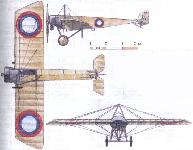 |
А.Шепс - Самолеты Первой мировой войны. Страны Антанты
|
| Разведчик Моран-Солнье тип G XI авиаотряда русской армии (1914г.). На этом самолете летал П.И.Нестеров
|
 |
В.Обухович, А.Никифоров - Самолеты Первой Мировой войны
|
| Моран-Солнье H
|
 |
А.Шепс - Самолеты Первой мировой войны. Страны Антанты
|
| Истребитель Моран-Солнье тип G французской армии (1915г.)
|
 |
Журнал - Flight за 1913 г.
|
| THE 80-H.P. MORANE-SAULNIER MONOPLANE. - A three-quarter view from the front.
|
 |
Журнал - Flight за 1913 г.
|
| THE 80-H.P. MORANE-SAULNIER MONOPLANE. - A three-quarter view from the back.
|
 |
Журнал - Flight за 1914 г.
|
| The Morane Monoplane (Nos. 10, 12, 17, 21).
|
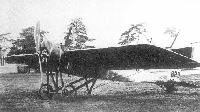 |
M.Goodall, A.Tagg - British Aircraft before the Great War /Schiffer/
|
| GW Type XIV was the Morane-Saulnier Type H produced under license.
|
 |
A.Weyl - Fokker: The Creative Years /Putnam/
|
| Fokker in the Morane-Saulnier monoplane he bought cheaply and had rebuilt. Standing in front of the aircraft are (l. to r.): Oberleutnant W. von Beaulieu, Hans Schmidt (Fokker’s personal mechanic), Bernard de Waal, Alexander von Bismarck, Hauptmann Walter (first commandant of the Fokker military flying school), and Hans Wunderlich (a flying pupil under the National Flugspende scheme).
|
 |
Журнал - Flight за 1913 г.
|
| GUSTAV HAMEL'S MORANE-SAULNIER ON THE STARTING LINE FOR THE AERIAL DERBY ON SATURDAY. - In this photograph the small wing span of this racing machine can be appreciated.
|
 |
L.Opdyke - French Aeroplanes Before the Great War /Schiffer/
|
| The Morane Type G 2-seater: the basic Morane monoplane.
|
 |
P.Jarrett - Pioneer Aircraft: Early Aviation Before 1914 /Putnam/
|
| When monoplanes were modified to perform the first aerobatics, including inverted flight and loops, one of the most conspicious alterations was that to the bracing pylons or cabanes, which were made taller to increase the angle of the bracing cables to the upper wing surfaces, thereby reduving the tension in the cables to enable them to meet higher loads. This is Gustav Hamel's 80hp looping Morane-Saulnier at Cambridge in 1914.
|
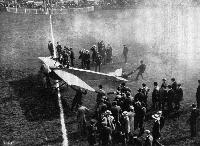 |
Журнал - Flight за 1913 г.
|
| Brindejonc des Moulinais and his lady passenger on the Morane-Saulnier just starting for his attempt to beat the English altitude record at Hendon on Saturday last.
|
 |
P.Jarrett - Pioneer Aircraft: Early Aviation Before 1914 /Putnam/
|
| Although the Morane monoplanes were trickier to fly than the Bleriots, they do not appear to have suffered so much from wing troubles. In this study of Brindejonc de Moulinais about to depart in 1913, the normal, very short bracing pylon in front of the cockpit is apparentm as well as the continued use of human restraint in lieu of chocks.
|
 |
Журнал - Flight за 1914 г.
|
| Mr. Noel just "off" on his Morane at Hendon.
|
 |
Журнал - Flight за 1913 г.
|
| Hamel, the winner of the Aerial Derby, just getting away from Hendon Aerodrome.
|
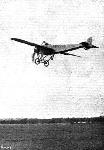 |
Журнал - Flight за 1914 г.
|
| A turn round Hendon Aerodrome on the Morane-Saulnier.
|
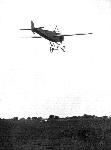 |
Журнал - Flight за 1914 г.
|
| Mr. Frank Goodden flying the Morane-Saulnier at Hendon Aerodrome.
|
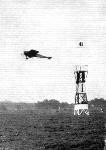 |
Журнал - Flight за 1913 г.
|
| M. Brindejonc des Moulinais giving an exhibition flight riendon on Saturday on the Moraoe-Saulnier.
|
 |
Журнал - Flight за 1914 г.
|
| The first man to return to Hendon Aerodrome in the Aerial Derby. - Louis Noel on his Morane.
|
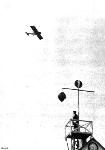 |
Журнал - Flight за 1914 г.
|
| LONDON-MANCHESTER-LONDON RACE. - Finish by Brock on his Morane-Saulnier machine on Saturday last, when he won this race in magnificent time. The time estimated by the handicapper for him to arrive back at Hendon was 5.60 p.m., and within ten seconds of that time Mr. Brock passed the winning post. Note the clock in our photograph, which points exactly to the 5.50.
|
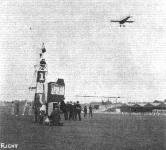 |
Журнал - Flight за 1914 г.
|
| Louis Noel, on the 80 h.p. Morane-Saulnier, after having finished first in the final heat of the speed handicap at Hendon last Saturday, completing an extra lap whilst the other competitors are finishing the heat.
|
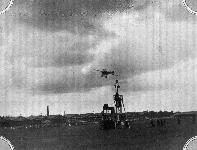 |
Журнал - Flight за 1915 г.
|
| A Morane-Saulnier rounding Pylon I at Hendon, as flown by Mr. W. L. Brock at Hendon Aerodrome during last season.
|
 |
Журнал - Flight за 1913 г.
|
| A couple of snaps at the Audemars, Brindejinc and Guillaux match at Juvicy, showing some banking by Brindejonc des Moulinais.
|
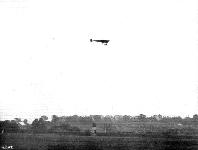 |
Журнал - Flight за 1913 г.
|
| Gustav Hamel finishing and winning the Second Aerial Derby at Hendon on Saturday, Sept. 20th, 1913, on his Morane-Saulnier monoplane.
|
 |
Журнал - Flight за 1914 г.
|
| THE FINISH OF THE AERIAL DERBY AT HENDON. - Mr. W. L. Brock passing over the finishing line on his Morane.
|
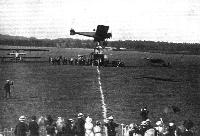 |
Журнал - Flight за 1914 г.
|
| R. H. Carr winning the Cross-Country Race, with Miss Saunders as passenger, on the Morane-Saulnier mono, at Hendon on Saturday.
|
 |
Журнал - Flight за 1914 г.
|
| LOOPING THE LOOP BY COMMAND OF THE KING. - Mr. Gustav Hamel upside down over Windsor Castle before the King on Monday. Our photograph shows the spectators watching the evolutions from the Long Walk.
|
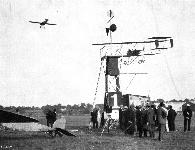 |
Журнал - Flight за 1913 г.
|
| ROUND PYLON ONE. - Verrier, on the Maurice Farman biplane, and Slack, above, on the Morane-Saulnier.
|
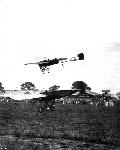 |
Журнал - Flight за 1913 г.
|
| A remarkable photographic record of an incident in the International contest at Hendon on Saturday. - Brock on the Bleriot winning by a few feet only from Marty on the Morane-Saulnier, who flew underneath him as they crossed the line.
|
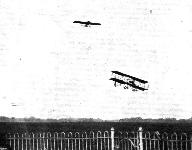 |
Журнал - Flight за 1914 г.
|
| A MEMORY. - The late Mr. Philippe Marty flying in a race at Hendon.
|
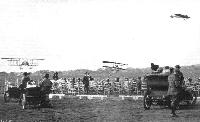 |
Журнал - Flight за 1913 г.
|
| A FINE FINISH AT HENDON. - Marty, Verrier and Manton finishing in the order given in the first heat of the Speed Handicap on "Motor Cycle Day."
|
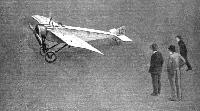 |
Журнал - Flight за 1914 г.
|
| The winner of the Aerial Derby, W. L. Brock, just come to rest in the Hendon Aerodrome.
|
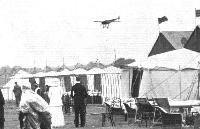 |
Журнал - Flight за 1913 г.
|
| Mr. Robert Slack arriving at the London Aerodrome on the Morane-Saulnler after his magnificent flight from Paris.
|
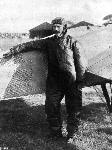 |
Журнал - Flight за 1913 г.
|
| MR. ROBERT B. SLACK.
|
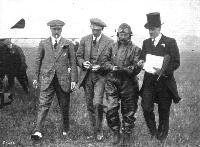 |
Журнал - Flight за 1913 г.
|
| PARIS TO LONDON FLIGHT. - Mr. Robert Slack being escorted across the aerodrome immediately after his arrival at Hendon, by Capt. Tyrer and Mr. R. T. Gates.
|
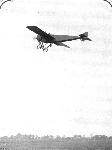 |
Журнал - Flight за 1913 г.
|
| Mr. Robert Slack flying the Morane-Saulnier at Hendon after his flight from Paris last week.
|
 |
Журнал - Flight за 1913 г.
|
| Gilbert just taking his seat in the Morane-Saulnier monoplane, ready for his start back to Paris on Sunday last.
|
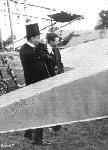 |
Журнал - Flight за 1913 г.
|
| Mr. George Grossmith at the Aerial Fete at Hendon last week, showing his little son the Morane-Saulnier in which Robert Slack flew from Paris.
|
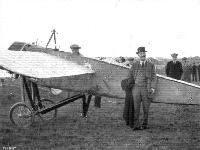 |
Журнал - Flight за 1913 г.
|
| Mr. Gustav Hamel, the winner of the Aerial Derby, in his Morane-Saulnier. Standing by the machine is Mr. "Shell" Cates, through whom the splendid cup and prizes were given for the sealed handicap.
|
 |
Журнал - Flight за 1913 г.
|
| Lord Carbery and his 80 h.p. Gnome Morane-Saulnier at Le Crotoy, where he landed, having lost his bearings, upon the occasion of his recent flight across the Channel. Mr. Oddey, to whom we are indebted for these snaps, proved of considerable value to Lord Carbery, he being the only Englishman on the spot conversant with the journey, he having, it will be remembered, made the Cross-Channel journey with Mr. Sydney Pickles, as recorded in these pages. On the left Lord Carbery is seen filling up at Crotoy prior to his restart for England.
|
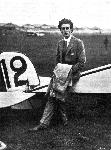 |
Журнал - Flight за 1914 г.
|
| LORD CARBERY the well-known amateur who files a Morane for sport. He made a surprise flight from Paris to London in the middle of last August, soon after securing his brevet. He has entered for the Aerial Derby.
|
 |
Журнал - Flight за 1914 г.
|
| LONDON-PARIS LONDON RACE. - Brock's superb landing at Hendon on his return from Paris.
|
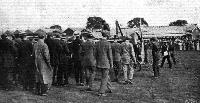 |
Журнал - Flight за 1914 г.
|
| LONDON-PARIS-LONDON RACE. - Brock standing up in his machine immediately on his,return to Hendon after his splendid achievement in the Paris flight.
|
 |
Журнал - Flight за 1914 г.
|
| LONDON-PARIS-LONDON RACE. - Brock's reception at Hendon after winning the race. On the left, the Pilot, the Press and the People; on the right Brock being "carried" round the enclosures after his victory.
|
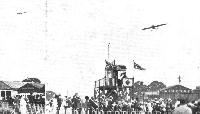 |
Журнал - Flight за 1914 г.
|
| LONDON-PARIS-LONDON RACE. - Garros, the second man, arriving from Paris. On the left he is seen coming into the aerodrome on his first return, when, being informed he had missed the turning point at Harrow Church, he at once took wing again and flew back and rounded this point. On the right he is returning after this little episode, and thus formally ranking as second in.
|
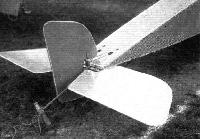 |
Журнал - Flight за 1913 г.
|
| The tail of the Morane-Saulnier monoplane, showing the very neat arrangements of the rudder and elevator wires and levers.
|
 |
Журнал - Flight за 1914 г.
|
| A neat way of exhibiting a machine - one of the Morane-Saulnier monoplanes.
|
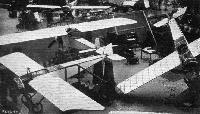 |
Журнал - Flight за 1913 г.
|
| The Morane-Saulnier stand at the Paris Salon.
|
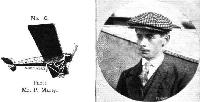 |
Журнал - Flight за 1913 г.
|
| Pilot: Mr. P. Marty.
|
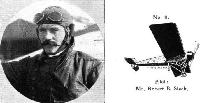 |
Журнал - Flight за 1913 г.
|
| Pilot: Mr. Robert B. Slack.
|
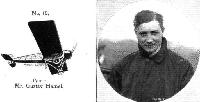 |
Журнал - Flight за 1913 г.
|
| Pilot: Mr. Gustav Hamel.
|
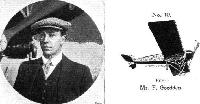 |
Журнал - Flight за 1914 г.
|
| Pilot: Mr. F. Goodden.
|
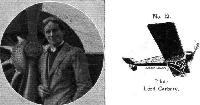 |
Журнал - Flight за 1914 г.
|
| Pilot: Lord Carbery.
|
 |
J.Forsgren - Swedish Military Aircraft 1911-1926 /Centennial Perspective/ (68)
|
| Upon outbreak of war in August 1914, the Morane Saulnier MS 3L was incorporated into Army service. By that time, it was called 'The fastest aircraft in Northern Europe'. Note the Three Crowns national insignia beneath the left wing. Unfortunately, the person standing in front of the airplane is unidentified. Via Swedish Aviation Historical Society
|
 |
J.Forsgren - Swedish Military Aircraft 1911-1926 /Centennial Perspective/ (68)
|
| The army pilot Nils Kindberg in the Morane Saulnier MS 3L. The picture was taken at Malmen on July 17,1915. Via Swedish Aviation Historical Society
|
 |
В.Обухович, А.Никифоров - Самолеты Первой Мировой войны
|
|
|
 |
L.Opdyke - French Aeroplanes Before the Great War /Schiffer/
|
| The Morane H, a single-seater resembling - but perhaps preceding! - the Type G.
|
 |
H.Cowin - Aviation Pioneers /Osprey/
|
| The single seat Morane-Saulnier Type M made its first appearance during the late summer of 1912 in civilian guise aimed at the sports and racing enthusiast. Powered by a 80 hp Gnome, the Type M had a top level speed of 78mph and was soon offered in modified armoured form to the military as a fast, unarmed scout. While the French appear not to have acquired the Type M, the British War Ministry are reported to have bought three, while the machine seen here, serial no. 5707, was one of 25 ordered by the British Admiralty. The purchase was subsequently cancelled.
|
 |
K.Delve - World War One in the Air /Crowood/
|
| French Morane monoplane with an 80hp Gnome engine. Used by both British and French squadrons, the Morane monoplanes were among the first types to be equipped with a forward-firing machine gun.
|
 |
K.Delve - World War One in the Air /Crowood/
|
| The similarity between the Morane H and the German monoplanes it inspired is obvious in this picture of a captured H. Note the manufacturer's badge on the cowling.
|
 |
J.Herris - Gotha Aircraft of WWI /Centennial Perspective/ (6)
|
| The modified Friedel-Ursinus B.1092/14 and a captured Morane monoplane at FEA 9 in Darmstadt for a size comparison. Aerodynamically-balanced ailerons have been fitted and the nose radiators have been replaced by larger, twin radiators on each engine. A long cellon window is in the fuselage side over the wing.
|
 |
H.Nowarra, G.Duval - Russian Civil and Military Aircraft 1884-1969
|
| A Morane-Saulnier H monoplane, the pilots of which were armed with pistols or carbines.
|
 |
В.Шавров - История конструкций самолетов в СССР до 1938 г.
|
| "Моран-Ж" учебный
|
 |
A.Weyl - Fokker: The Creative Years /Putnam/
|
| Robert Morane and Raymond Saulnier in a Morane-Saulnier monoplane, 1913.
|
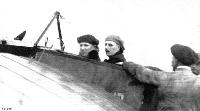 |
Журнал - Flight за 1913 г.
|
| M. Brindejonc des Moulinais and Capt. Tyrer on the Morane-Sauinier machine at Hendon on Saturday, just about to start for a flight after M. Brindejonc des Moulinais' arrival from the Continent.
|
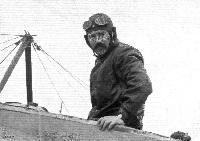 |
Журнал - Flight за 1913 г.
|
| Mr. Robert Slack, who brought the Paris Daily Mails from Paris to Hendon last week.
|
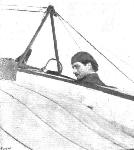 |
Журнал - Flight за 1914 г.
|
| Garros in his machine in which be obtained second place in the London-Paris-London Race.
|
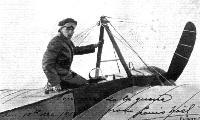 |
Журнал - Flight за 1914 г.
|
| A seasonable card from Louis Noel to hand this week, whose greetings we sincerely reciprocate, both on behalf of ourselves and, we feel sure, of our readers, who have followed in our pages all the good work which he has done here, and is now adding to on the side of the Allies.
|
 |
H.Nowarra, G.Duval - Russian Civil and Military Aircraft 1884-1969
|
| Another grey hair for the Chief Flying Instructor. Morane-Saulnier and Farman biplane after collision at a Russian flying school.
|
 |
Журнал - Flight за 1915 г.
|
| Two views of Mr. W. J. Clark's Morane-Saulnier scale model.
|
 |
Журнал - Flight за 1913 г.
|
| "AGAINST THE REGULATIONS." - An impression of Brindejonc des Moulinais' Morane-Saulnier crossing the City - St. Paul's in the foreground. Time about 2,50 p.m. Sunday. Note: The unusual prospective is caused by the spectator looking upwards at the monoplane.
|
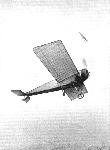 |
Журнал - Flight за 1913 г.
|
| "LADIES DAY" AT HENDON AERODROME. - The Morane-Saulnier and Bleriot circling round each other. From an original drawing by Roderlc Hill.
|
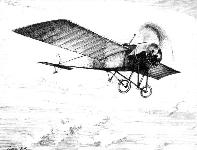 |
Журнал - Flight за 1913 г.
|
| An impression of Mr. Claude Grahame-White flying a Morane-Saulnier monoplane at Hendon in the first week of this month. From an original drawing by Mr. Roderic Hill.
|
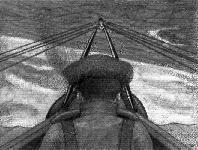 |
Журнал - Flight за 1914 г.
|
| An impression of looping the loop with Noel at Hendon.
|
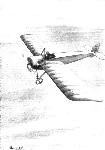 |
Журнал - Flight за 1914 г.
|
| A MEMORY. - Mr. Gustav Hamel, whose disappearance since Saturday has caused such widespread sorrow, flying his Morane monoplane on which he has accomplished such daring feats during the past months. From an original drawing by Roderic Hill.
|
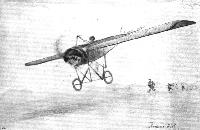 |
Журнал - Flight за 1914 г.
|
| LONDON-PARIS-LONDON RACE. - The return of Garros; he swept into the aerodrome only to find that he was - second! From an original drawing by Roderic Hill.
|
 |
Журнал - Flight за 1915 г.
|
|
|
 |
Журнал - Flight за 1915 г.
|
|
|
 |
Журнал - Flight за 1916 г.
|
| A French Morane monoplane engaging a German battleplane.
|
 |
H.Nowarra, G.Duval - Russian Civil and Military Aircraft 1884-1969
|
| September 8th, 1914 - P.N. Nesterov destroying a German aircraft by ramming; the first recorded instance of this method of attack. (From a contemporary painting.)
|
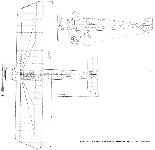 |
В.Шавров - История конструкций самолетов в СССР до 1938 г.
|
| Схема самолета "Моран-Ж" 14-метрового
|
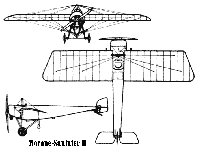 |
В.Кондратьев - Самолеты первой мировой войны
|
| Morane-Saulnier H
|
 |
Jane's All The World Aircraft 1913 /Jane's/
|
|
|
 |
Журнал - Flight за 1913 г.
|
| The extremely simple landing chassis of the Morane-Saulnier monoplane. On the right, sketch of the tail planes.
|
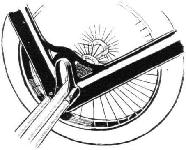 |
Журнал - Flight за 1913 г.
|
| Detail of Chassis.
|
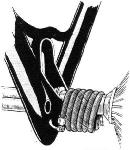 |
Журнал - Flight за 1913 г.
|
| Sketch showing the very neat attachment of the shock absorbers to chassis members.
|
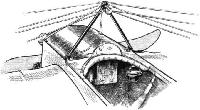 |
Журнал - Flight за 1913 г.
|
| The cockpit and dash. Note the method of pivoting the top pylon to upper longerons.
|
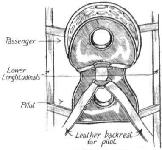 |
Журнал - Flight за 1913 г.
|
| The rather unusual seating arrangement.
|
 |
Журнал - Flight за 1913 г.
|
| Lower pylon and its fittings, and on the right, sketch showing method of anchoring lift cables to the chassis members.
|
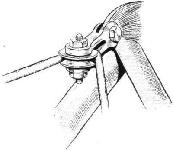 |
Журнал - Flight за 1913 г.
|
| Detail of top pylon. The forward bracing wires are carried round a pulley.
|
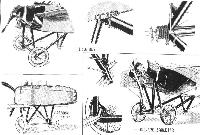 |
Журнал - Flight за 1915 г.
|
| Various undercarriages of the "Vee" type.
|
 |
Журнал - Flight за 1916 г.
|
| Various engine mountings and housings.
|
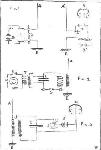 |
Журнал - Flight за 1914 г.
|
| Diagrams illustrating simple wireless telegraphy sets. Fig. 1. - The simplest form of transmitting and receiving set. Fig. 2. - The transmitting set of a more modern system. Fig. 3. - The receiving set for the same system.
|
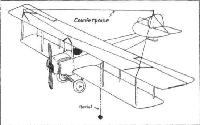 |
Журнал - Flight за 1914 г.
|
| Fig. 4. - Sketch showing the fitting of a "counterpoise," which takes the place of "earth" on a biplane; also showing the transmitting and receiving aerial.
|
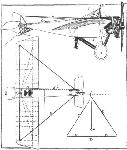 |
Журнал - Flight за 1914 г.
|
| Fig. 5. - Sketch showing the Marconi method of fitting the aerial to a Morane-Saulnier monoplane.
|
 |
Журнал - Flight за 1914 г.
|
| Fig. 6. - Detail views of the three Marconi units as fitted to a Morane-Saulnier monoplane. A, high frequency alternator and rotary disc-discharger. B, transmitting unit; 1, transformer; 2, choke coils; 3, condensers; 4 , jigger primary; 5, jigger secondary: 6, disc-discharge terminals; 7, aerial and counterpoise terminals. C, receiving unit: 2, batteries ; 3. battery cut-out; 4, telephones; 5, operating key; 6, aerial tuning inductance; 7, detector-crystal holder; 8, switches; 9, valvetuning condenser: 10, intensifier; 11, potentiometer.
|
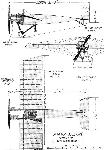 |
Журнал - Flight за 1913 г.
|
| THE 80-H.P. MORANE-SAULNIER MONOPLANE. - Plan and side and front elevation to scale.
|


































































































